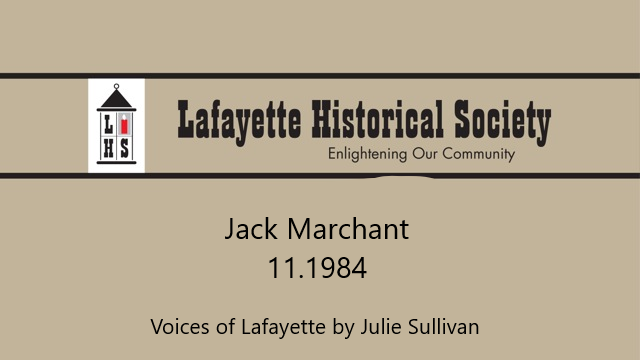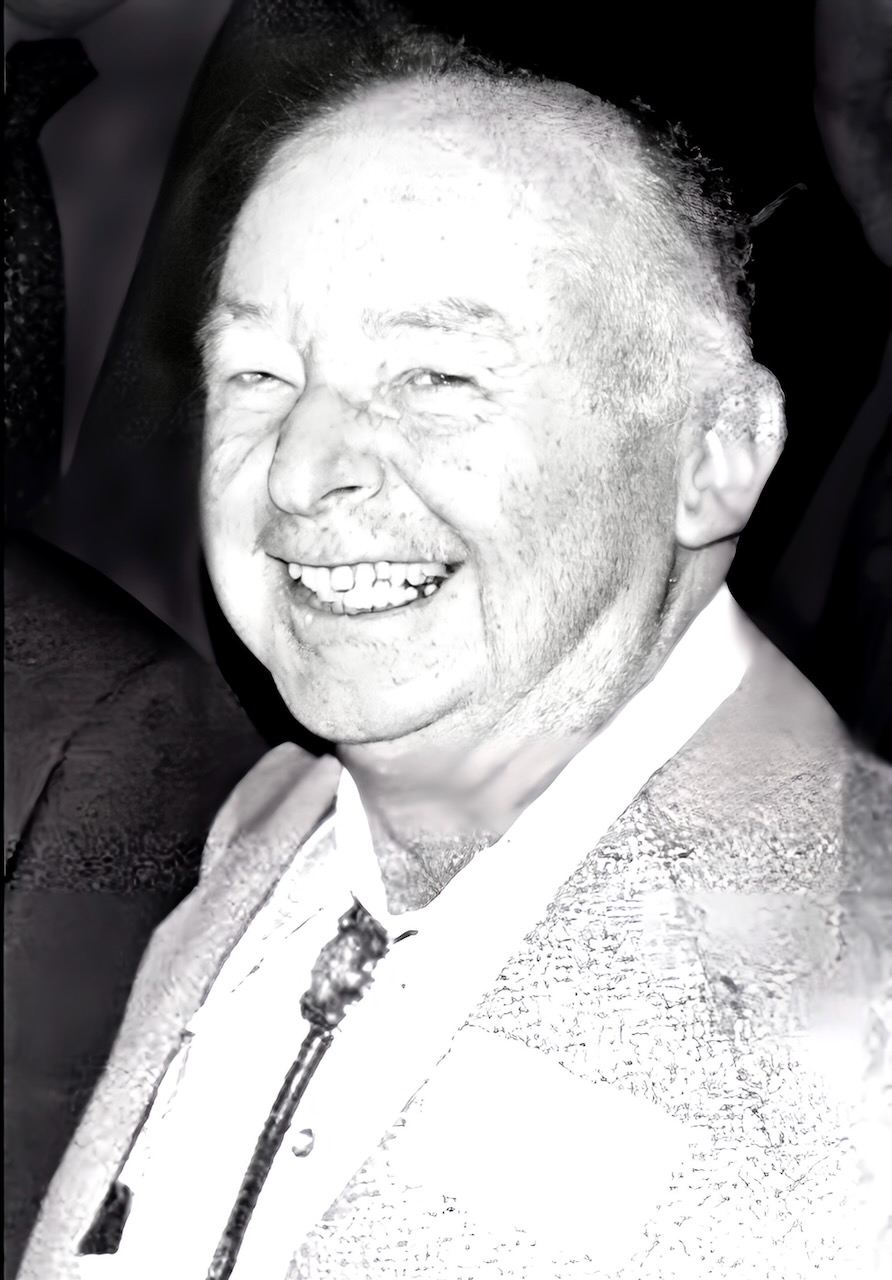Summary:
Jack Marchant was interviewed by Julie Sullivan in November, 1984. He grew up in Berkeley and went to Cal. In 1933 he became active as a homebuilder in Berkeley and Kensington. After service in World War II and being a teacher for a few years Jack resumed his homebuilding career in Lafayette, where he eventually built over 2000 homes. He was active in civic affairs and was elected to be a member of the first Lafayette City Council.
Oral History:
Jack Marchant built more than 2,000 homes in the Lafayette area, in developments like Happy Valley Dell, Peardale Estates, Silver Springs, Silver Dell, and Blackhawk (in Springhill Valley). He served on the board of Lafayette Federal Savings and Loan, was president of Lafayette Rotary Club, and in 1964 was named Lafayette Man of the Year. He and his wife, Esther, were members of the Lafayette Design Project, which spearheaded renovation of Plaza Park. A supporter of incorporation, Jack was elected to the first City Council in 1968.
Following is an excerpt from an oral history Jack and Esther Marchant provided to the Lafayette Historical Society.
Jack was born in Havana, Cuba. He lived in Berkeley from 1914- 1942, where he attended University High School and received an AB degree from the University of California in Berkeley. In 1933 he and his brother began building homes there. “Paul was my younger brother, and we worked together for a long time. We worked up in Kensington near Berkeley for quite a while before the war. I think we built about 90 houses up there in North Berkeley. It was under the name Marchant Brothers. Then Paul went overseas in the service, and he had a lot of experience with the Engineers Corps,” Jack explained.
“(My career in teaching) was in between. It was during the war. I was in the Maritime service and overseas for three years, and after that I taught school for three years.” In 1950 Jack returned to residential construction, and he and Paul formed Marchant Construction Company. “After that we joined with Don Lawrie and did business as Marchant and Lawrie for a short time.
“We built in Lafayette and Orinda and Danville and Rowland Orchards in Reliez Valley and many other areas. We always tried to do our best. We were always proud and glad to hear good things about the resale of Marchant homes. My brother, Paul, had a very tragic ending,” Jack added. “He was flying up in the mountains near Bishop, and he got caught in a big storm and was killed in a plane crash.”
When asked how he developed his ranch style design, “I had read several books which went into those old colonials back East, and I just kind of fell in love with that style. We also built a few contemporaries, but for the most part they were the California colonial ranch style.
“I bought land from Judge Hamlin in about 1953 (for the development) of Silver Springs. I would get together with Lee Schell, whom I brought into Rotary and is an old friend. We would get together and work out an estimate of what the land would cost to develop and work from there. We bought in acres of land, which would give a chance to do a nice job and mostly in colonial or California ranch style. As I say, we would buy a piece of land, and we would get together and make estimates of what the property would yield, how many sites, and if it looked good, we would go ahead with it.
“A good deal of the time we stayed with the same subcontractors, but now and again we would shop to make sure we were getting the right prices.” Jack and Hirsch Morton, a well known local architect, worked together over the years. “Originally he worked for us as a draftsman,” Jack explained.
“Lafayette’s incorporation was a good experience. Originally the first council acted as both the Planning Commission and the City Council, and later on we realized it was too big a job for the council alone to handle, so they formed a Planning Commission, and that was a big step in the right direction.
“For a while there it seemed like everybody in town was trying to have the biggest sign. You remember a guy named Tom Duffy who had the biggest sign? Esther was on the group called the Lafayette Design Project, and we had such a time getting the PG&E and telephone wires down in the middle of town. That project we did out there in Happy Valley, Happy Valley Dell, they are all underground.”
Jack served on the original board of Lafayette Federal Savings and Loan. “We used to meet at our home up the hill on McGraw Road for hours and plan this thing. At first we were going to have a bank, which is a little more flexible than a Federal Savings and Loan, but there was another group which was about ready to file, and they talked us into joining with them. That was the original group: Lawrence Wallace, Harry Morrison, Don Doughty, Lloyd King and Bruce Howard. Now it is called Cap Fed (today Citibank). Harry Morrison was the first president. He made himself president and chairman of the board too.”
Jack also served on the board of the Mt. Diablo Therapy Center in Pleasant Hill. “I want to tell you a story about an experience I had with Henry Kaiser many years ago. I wrote him a letter and asked if he would supply the concrete to be used for the Mt. Diablo Therapy Center. My kid brother and Essie (Esther) and I were interested in it, and Mr. Kaiser called me back and said he would furnish ALL the concrete we needed for that project, and I have never forgotten that.”
Jack sold land on Moraga Boulevard to the city for the Chateau Lafayette senior citizen complex. “We owned a big bunch of property on Moraga Boulevard. We owned the whole block in there from Moraga Road down to Moraga Boulevard and down to Golden Gate Way, with the exception of the nursery school. We still own a lot of it except what we sold to the Senior Citizens project. That project is well kept up and has a tremendous waiting list.”
Excerpted from “Voices of Lafayette” by Julie Sullivan. This book is available for purchase in the History Room.



I remember Jack’s building growing up in Lafayette in the 50’s and 60’s… he was always the yard stick that other builders aspired to be…. He did a lot of good for Lafayette in the early formative days…. His building was very well thought out…. I also remember him teaming up with Don Doughty that started and owned Orinda Pools… After WWII there were some good builders that helped to build Contra Costa County…. Harold Smith, Ken Hoffman and many others… their vision and planning is what makes living here so desirable…
Jack and I were elected to the first Lafayette City Council in 1968. His term was only two years and I missed him during my six years of service that followed his departure. He served as Vice Mayor during one of his years. He was the oldest of us, while I was the youngest. I always appreciated his kindness, his thoughtfulness, his integrity, his independence, and his self-effacing style. In his Council role and in his work, he was a wonderful, contributing citizen, always supported by his similarly wonderful spouse, Essie.